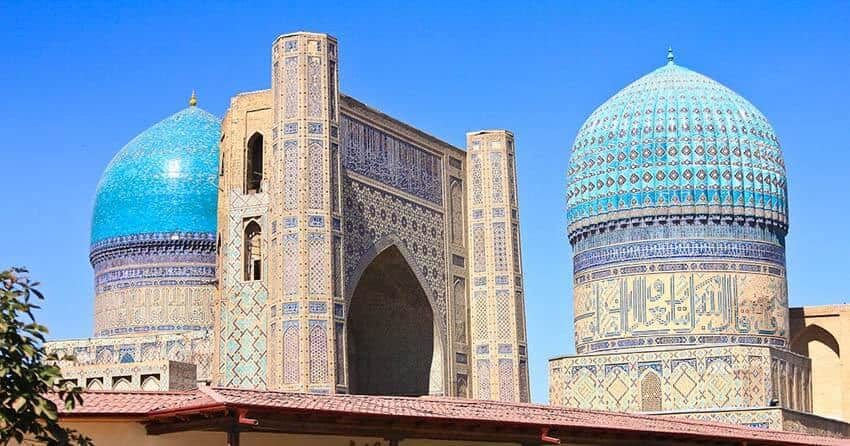Blue Tiles and a Kiss

Bibi Khanum was the eldest wife of Taimur. There is a wonderful story of love and revenge attached to this mosque, which is named after her. It goes like this:
Taimur had gone on one of his invasions and Bibi Khanum wanted to build a beautiful mosque to present it to him on his return as a token of her love. She engaged the chief architect of Taimur to build it who promised to complete it in time of Taimur’s return. Work proceeded apace and the structure came up. Soon news came of Taimur’s impending return and Bibi Khanum implored the architect to quickly complete the mosque as the work had suddenly slackened.
Bibi Khanum asked the architect the cause of delay who replied that he had fallen in love with Bibi Khanum and if he completed the work, he will never be able to see Bibi Khanum again.
She was horrified at the man’s audacity despite knowing that she was Taimur’s wife. But the architect was adamant and argued that she might be the wife of Taimur but after all she was a woman. Bibi Khanum countered him saying that there may be many bottles containing various liquids but only one contained wine. She was defeated by his logic that he may paint many eggs in different colours but their content will remain the same.
Finally, a compromise was arrived at. The architect said that he would surely complete the mosque but only if she allowed him to kiss her cheek once. Bibi Khanum agreed and when the architect kissed her, she put her hand on the cheek. So the architect was only able to kiss her hand. But still her cheek somehow bore the imprint of the kiss. The mosque was completed and only one minar’s dome remained to be built when Taimur returned.
Taimur saw the mark on his wife’s cheek and asked her the reason. Bibi Khanum honestly told him what had happened. A very angry Taimur then went to meet the architect and seeing him coming with a naked sword, the architect ran to the incomplete minar to hide. Taimur chased him and the architect went up and up and finally flew away as a bird from its open top to the West.
Between legend and history, it seems that the architect was really a master technician in making and using blue tiles. But due to some conflict with Taimur he ran away to Persia. It is only after his arrival that blue tiles became a feature of West Asian architecture as well.
The blue tiles remained a part of Uzbek architecture. At Samarkand’s Gur-Emir, there is the mausoleum of Taimur dynasty whose blue-ribbed dome decorated with glazed tiles blends beautifully with the sky. Here Taimur also lay buried.
I went down the vault to see Taimur’s resting place. It was a simple grave but inscribed on his grave door are the taunting words: “The happiest man is he who rejected the world before the world rejected him!”
Samarkand is history itself; it is a Phoenix city. Situated at the cross roads of civilisation, it is thought to be more than 2500 years old. The old Silk Road passed through Samarkand. Conquered by Alexander, devastated by fanatic Arabs, plundered and razed by the hordes of Genghis Khan, Samarkand rose from its ruins again and again like a Phoenix.
It is also the place where the great Uzbek scholar, astronomer and mathematician Ulugbek built an observatory. With an instrument he built, he calculated in 1429 that the Earth completed one orbit around the Sun in 365 days 6 hours 10 minutes and 4 seconds. Today’s modern calculation differs with him by only 58 seconds!
Ulugbek was the grandson of Taimur and he was the most peace-loving ruler who visited many countries to study their traditions, culture and customs. He brought many scientists to help develop science in his country.
There is an ensemble of 13 monuments and mausoleums at the Shah-i-Zindeh square of Samarkand. The oldest one is thought to be that of Prophet Mohammad’s cousin Kusam-ibn-Abbas. Another mausoleum is of an unnamed beautiful young girl who died before her marriage where these words are inscribed: “She was as beautiful as the Moon, as slender as the Cyprus and as wise as Socrates”.
Some cities embody the history of whole nations, countries and generations. Samarkand is one of them. Its earliest mention was in 329 BCE rebuilt over the hill city of Afrosiab ruined by the Mongols. But Samarkand never gave up.
I visited Samarkand in 1981 and have detailed my experiences in my book Twenty Thousand Kilometers through Soviet Union.
